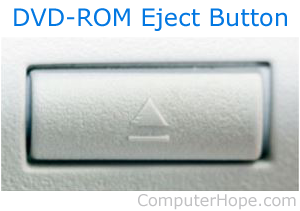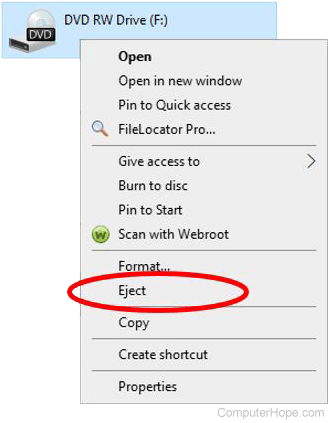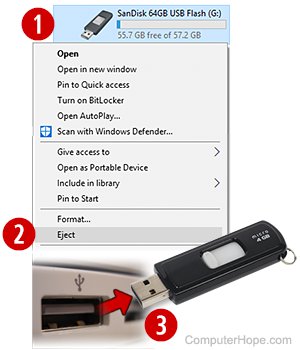Eject
Eject may refer to any of the following:

1. With removable disk drives, eject means disengaging the medium (removable disk), so it may be removed. For instance, with a CD-ROM (compact disc read-only memory) drive, ejecting the disk opens the tray. Or, if the CD-ROM drive uses slot insertion, ejecting will mechanically reposition the CD so it sticks out of the slot.
The picture is a close-up example of an eject button and icon on the front of a CD-ROM drive. It's usually represented by a triangle with a line underneath and on the drive's right side.
Eject CD or DVD through the operating system
Operating systems like Windows and macOS allow users to eject a CD or DVD (digital versatile disc) using a built-in software eject option. If the eject button on the disc drive is not working, the software eject option lets you remove a CD or DVD from the drive.
Windows computer
You can eject a CD (compact disc) or DVD on a Windows computer through File Explorer.
- Open File Explorer.
- In the left navigation pane, click This PC.
- On the right side of File Explorer, right-click the CD or DVD drive and select Eject in the pop-up menu.

You can also use the OpenCloseDriveEject program from SoftwareOK to eject drives.
macOS computer
You can eject a disc from the desktop or through Finder on a Mac computer.
- On the macOS desktop, find and click the disc drive icon.
- In the menu bar at the top of the desktop, click File and select Eject.
OR
- Open Finder.
- In the left sidebar, find the disc drive.
- Click the eject icon
 next to the disc drive name.
next to the disc drive name.
Linux computer
You can eject a disc from the command line on a Linux computer.
- If using a Linux OS (operating system) with a GUI (graphical user interface), open the terminal or command-line shell interface.
- At the command line, type eject and press Enter.
To close the disc drive tray, at the command line, type eject -t.
How to create an eject symbol in HTML
To create the eject symbol (⏏) in HTML (hypertext markup language), use the special HTML character code ⏏ in your HTML code.

2. With USB drives, eject is an operating system feature that lets the operating system know the drive is about to be disconnected. The operating system completes any read or write operations on the drive and unmounts it from the computer.
If you do not eject a USB drive before it's disconnected, there's a chance that data on the drive can be corrupted. For this reason, it's best to always eject your USB drive before physically disconnecting it from the USB port.

3. With floppy disk drives, eject is disengaging and removing a floppy diskette from the drive. Press the eject button on the front of the drive to eject a floppy diskette from a floppy disk drive. The diskette is ejected part way, allowing you to grab it and carefully pull it out the rest of the way.
The picture shows the eject button on a 3 1/2" floppy disk drive.
4. With Linux and Unix, eject is a command to eject removable media using the command line. See our eject command page for further information about this command.
